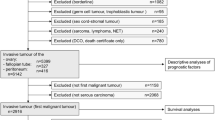Abstract
Introduction
Recent molecular research has revolutionized the understanding of ovarian cancer. It is now non-controversial that the term ovarian cancer summarizes a heterogenous group of malignant epithelial tumors. Findings of large clinical trials investigating surgical and systemic therapeutic approaches have defined the most important prognostic parameters. Therefore, the oncology committee of FIGO, headed by the South African gynecologic oncologist Lynette Denny, took the effort to revise the FIGO classification of ovarian cancer that was implemented in 1988.
Material and Methods
The recent publication of Jaime Prat describing the new FIGO classification is summarized. The major changes compared to the hitherto existing classification from 1988 are presented.
Results
The primary anatomy is now documented (ov for ovarian, ft for fallopian tube, p for peritoneal, X for not assessed). The histological subtype is also documented (HGSC for high-grade serous carcinoma, LGSC for low-grade serous carcinoma, MC for mucinous carcinoma, CCC for clear cell carcinoma, and EC for endometrioid carcinoma). There is no stage I peritoneal cancer. Stage IC is subdivided into intraoperative rupture (IC1), pre-operative rupture (IC2), and malignant ascites or peritoneal washings (IC3). Due to its anatomic position within the pelvis, metastasis to the sigmoid colon is considered stage II. Former stage IIC has been erased. Stage IIIA1 and IIIA2 have been defined for intra-pelvic tumor with metastasis to retro-peritoneal lymph nodes up to 1 cm (IIIA1) or larger than 1 cm (IIIA2). With this, some of the former stage IIIC cases become IIIA and some IIIB, respectively. Involvement of retroperitoneal lymph nodes must be proven cytologically or histologically. Stage IV has been subdivided into IVA (malignant pleural effusions) and IVB (parenchymal metastases and/or extra-abdominal metastases including tumors in inguinal lymph nodes or lymph nodes outside of the abdominal cavity, umbilical tumor deposit, and transmural bowel infiltration (with mucosal involvement).
Conclusion
The new FIGO classification takes into account the recent findings on the origin, pathogenesis, and prognosis of different ovarian cancer subtypes, summarizes groups of tumors pragmatically, and implies a reproducible and stage-dependent therapeutical approach.
Similar content being viewed by others
References
Prat J (2014) Staging classification for cancer of the ovary, fallopian tube, and peritoneum. Int J Gynecol Obstet 124(1):1–5
http://www.cancer.org/Cancer/OvarianCancer/DetailedGuide/ovarian-cancer-key-statistics. Accessed June 2014
Shih Ie M, Kurman RJ (2004) Ovarian tumorigenesis: a proposed model based on morphological and molecular genetic analysis. Am J Pathol 164:1511–1518
Meinhold-Heerlein I, Bauerschlag D, Hilpert F, Dimitrov P, Sapinoso LM, Orlowska-Volk M, Bauknecht T, Park TW, Jonat W, Jacobsen A, Sehouli J, Luttges J, Krajewski M, Krajewski S, Reed JC, Arnold N, Hampton GM (2005) Molecular and prognostic distinction between serous ovarian carcinomas of varying grade and malignant potential. Oncogene 24:1053–1065
Kurman RJ, Shih Ie M (2011) Molecular pathogenesis and extraovarian origin of epithelial ovarian cancer—shifting the paradigm. Hum Pathol 42(7):918–931
Piek JM, van Diest PJ, Zweemer RP et al (2001) Dysplastic changes in prophylactically removed fallopian tubes of women predisposed to developing ovarian cancer. J Pathol 195:451–456
Przybycin CG, Kurman RJ, Ronnett BM et al (2010) Are all pelvic (nonuterine) serous carcinomas of tubal origin? Am J Surg Pathol 34:1407–1416
Elattar A, Bryant A, Winter-Roach BA, Hatem M, Naik R (2011) Optimal primary surgical treatment for advanced epithelial ovarian cancer. Cochrane Database Syst Rev 10(8):CD007565. doi:10.1002/14651858.CD007565
du Bois A, Reuss A, Pujade-Lauraine E et al (2009) Role of surgical outcome as prognostic factor in advanced epithelial ovarian cancer: a combined exploratory analysis of 3 prospectively randomized phase 3 multicenter trials: by the Arbeitsgemeinschaft Gynaekologische Onkologie Studiengruppe Ovarialkarzinom (AGO-OVAR) and the Groupe d’Investigateurs Nationaux Pour les Etudes des Cancers de l’Ovaire (GINECO). Cancer 15:1234–1244
Conflict of interest
None.
Author information
Authors and Affiliations
Corresponding author
Rights and permissions
About this article
Cite this article
Zeppernick, F., Meinhold-Heerlein, I. The new FIGO staging system for ovarian, fallopian tube, and primary peritoneal cancer. Arch Gynecol Obstet 290, 839–842 (2014). https://doi.org/10.1007/s00404-014-3364-8
Received:
Accepted:
Published:
Issue Date:
DOI: https://doi.org/10.1007/s00404-014-3364-8




